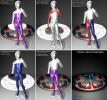Spinal Cord Hemisection, Brown-Sequard Syndrome, Hemicord Syndrome, Hemiparaplegic Syndrome
- See Also
- Epidemiology
- Uncommon Spinal Injury, accounting for only 4% of spinal cord injuries per year in the U.S.
- Pathophysiology
- Hemisection of the spinal cord most affects the posterior cord
- Unilateral (hemi-cord) cord injury affecting the dorsal columns, Corticospinal tract and Spinothalamic Tract
- Spinothalamic Tract crosses to the contralateral side (giving the crossed effects)
- Images
- Causes
- Penetrating Trauma (most common)
- Vertebral Fracture with lateral cord compression
- Blunt Spinal Cord Injury
- Disc Herniation
- Epidural Hematoma
- Decompression Sickness complication
- Signs
- Ipsilateral motor weakness
- Ipsilateral proprioception and vibratory Sensation loss below the lesion
- Contralateral pain and TemperatureSensation loss starting two levels below the lesion
- Associated Conditions
- Management
- Consult neurosurgery for possible decompression surgery
- Avoid Corticosteroids (not recommended)
- Prognosis
- Brown-Sequard Syndrome has an overall good prognosis
- Motor function is recovered in more than half of cases
- References
- Decker in Chorley and Bachur (2014) Overview of Cervical Spinal Cord Injuries..., UpToDate, Wolters-Kluwer
- Rodriguez, Winger, Poulo and Glunk (2023) Crit Dec Emerg Med 37(3): 23-9
- Wagner (1997) Emerg Med Clin North Am 15:699-711 [PubMed]
